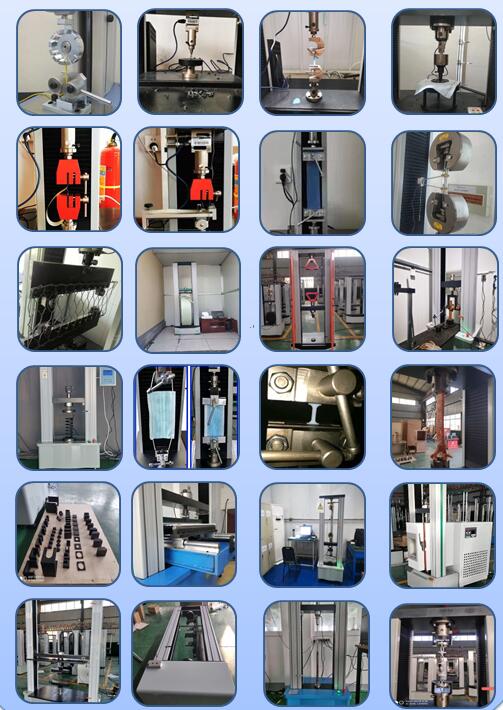News
Tensile testing machine fixture requirements and differences
Tensile testing machine fixture requirements and differences
The universal tensile testing machine can complete various mechanical performance tests by configuring different fixtures. The fixture is an indispensable part of the electronic universal tensile testing machine. According to different test methods and test requirements, the fixtures can be roughly divided into tensile fixtures, compression fixtures, bending fixtures, peeling fixtures, shearing fixtures, etc. The following is an introduction to the electronic universal tensile testing machine fixtures.
Material of the fixture
1) For ordinary metal and non-metal samples, the jaws of the fixture directly hold the sample. Such fixtures usually use high-quality alloy structural steel, alloy high-carbon steel, low-carbon alloy steel, cold work die steel, etc. The strength and wear resistance of the test fixture can be enhanced by quenching and tempering, carburizing and quenching, or special steel can be placed at the jaws or the surface of the jaws can be sprayed with gold grit to enhance the strength and wear resistance of the fixture.
2) Some samples have low tensile strength and need to use a tensile fixture with small test force. The surface of the fixture is usually made of sticky soft rubber, such as a tensile fixture for samples such as plastic films and fiber filaments.
3) The tension clamp body is usually made of medium carbon steel and alloy structural steel. The mechanical properties of the clamp body can be increased by adopting a suitable heat treatment process. Sometimes light-weight aluminum alloys and special metals are also used for some special requirements.
Types of Fixtures
The fixture applies force to the sample by firmly clamping the sample, and the test force that the fixture can withstand is an important performance of the fixture. It determines the size and working strength of the fixture. The material of the sample is divided into metal and non-metal, and the shape is also large and small. The test force that the sample can withstand ranges from tens of centinewtons to tens of tons, and the sample size ranges from 0.006mm gold wire to 1m PVC pipe. Therefore, the test fixture should be selected or designed according to different test forces and the shape and size of the sample.

The structure of the fixture
1) The fixture is mainly designed according to ISO, ASTM, DIN, GB, JIS and other test standards and samples of finished or semi-finished products. In the test standard, there are usually strict regulations on sample preparation and test method, and different fixtures can be designed according to the sample and test method. For finished or semi-finished samples, the tensile fixture is mainly designed according to the shape, size and material of the sample.
2) The structure of the fixture is various, and there is no fixed structure. For example, the wire can use a winding fixture, or it can be clamped with two flat plates; the metal sheet can use a wedge-shaped fixture or a pair of clamps. There will be differences in the performance of domestic and foreign fixtures and fixtures between different companies, which are related to the overall level of the company and the experience of designers.
3) The tensile test fixture is essentially a locking structure. The mechanical locking structure includes threads, slopes, eccentrics, levers, etc. The fixture is the combination of the locking mechanism. When the sample is different and the test force is different, the structure of the fixture is also quite different. The specimen with large test force usually adopts the inclined surface clamping fixture, and the clamping force increases with the increase of the test force; the shoulder specimen adopts the suspension structure. If the fixtures are divided by structure, they can be divided into wedge-shaped fixtures, which refer to fixtures that adopt the principle of bevel locking; wafer-type fixtures refer to fixtures that adopt single- or double-sided screw-topping principle structures; winding-type fixtures refer to the sample is locked by winding; the eccentric clamp refers to the clamp with the structure of the eccentric locking principle; the lever clamp refers to the clamp with the structure of the lever force amplification principle; the shoulder clamp refers to the clamp suitable for the shoulder sample; Bolt fixtures refer to fixtures suitable for testing thread strength of bolts, screws, studs, etc.; 90° peel fixtures refer to fixtures suitable for vertical and straight peeling of two samples. The structures of these fixtures have their own advantages and disadvantages, such as: wedge-shaped fixtures, the initial clamping force is small, and the clamping force increases as the test force increases. For the clamping fixture, the initial clamping force is large, and the clamping force decreases with the increase of the test force.
We specializes in the production and sales of electronic and hydraulic universal testing machine,electronic and hydraulic tensile testing machine, bending testing machine, horizontal tensile testing machine, impact Testing machine, concrete cement compression testing machine, compressive and flexural integrated testing machine, pellet compression testing machine, manhole cover compression testing machine, tensile stress relaxation testing machine, etc. Welcome your calling or visit
Categories
Contact Us
- +86-18615632092
- wtbequipment@hotmail.com
- sophie-tester
- +86-18615632092




 售前客服
售前客服